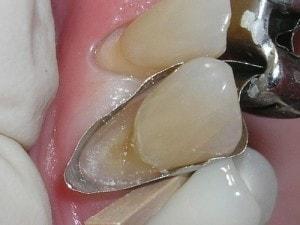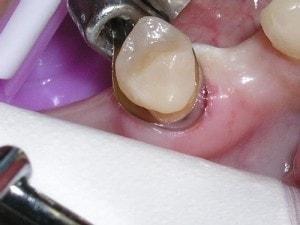Class V Composite
The following are reasons some sub gingival Class V’s are not easily isolated:
- Thin friable mucosal with little or no attached gingiva. Sulcus is very shallow. No room for the retraction cord.
- Decay is deep sub gingival. Retraction cord can not isolate the margin because the decay is flush with the attachment, and the gingiva is obscuring access to the cavity prep.
- Area is difficult to isolate from saliva contamination.
-
Class V Tooth #6

Erosive lesion below gingival margin
The gingiva had a shallow sulcus, and the attachment was delicate. Therefore, did not want to isolate with retraction cord.
-

Greater Curve standard band in place
Greater Curve band provided isolation as well as access to the cavity prep.
-

Bonding agent placed
After placing bonding agent, cavity prep was layered with applications of flowable composite.
-

Final restoration
-
Class V tooth #29
Caries make isolation difficult
Caries extended around mesial, buccal, and distal of tooth # 29 making isolation very difficult.

-
Greater Curve band has the entire cavity prep isolated
Further isolation was enhanced with a “Dent-a-pop” to the lingual and a Dri-aid against the buccal mucosa.

-
flowable composit placed in increments
After placing a bonding agent a flowable composite was placed in increments to the height of the “Greater Curve” periphery. In areas where access was minimal the top of the band was pulled away with an explorer to allow the tip of the flowable applicator to reach the cervical margins.

-
Final restoration
Adjusted to accommodate partial denture clasp

-
Class V Tooth #19

Mirror image of a mesial, lingual, and distal cavity prep on tooth #30
Preventing saliva contamination of the restoration can be difficult.
-

Greater Curve band isolates as well as provides access to the cavity prep.
After placing bonding agent the tooth was restored with increments of flowable composite.
-

Final Restoration













Connect